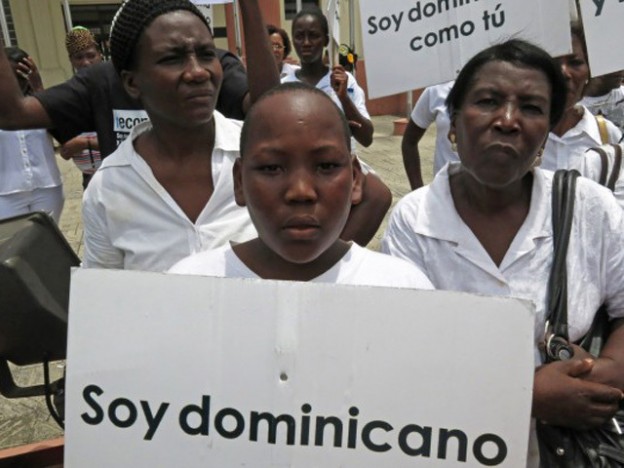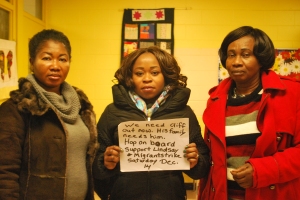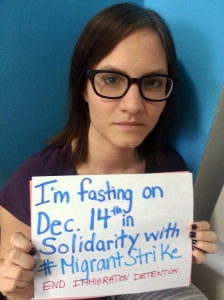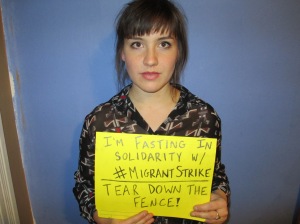From IRIN.
Photo: Carmela Fonbuela/ IRIN: IDPs recently arrived to Metro Manila following the Category 5 Super Typhoon Haiyan
MANILA, 3 December 2013 (IRIN) – Almost 20,000 typhoon survivors have arrived in the Philippine capital region of Manila since Super Typhoon Haiyan devastated a large area across the central island provinces nearly one month ago, displacing a total of four million people.
“We did not expect this massive devastation. We were not prepared. It would have been better if they [had been] evacuated to neighbouring provinces so it will be easier for them to return when the situation has normalized,” said Alice Bonoan, regional director of the Department of Social Welfare and Development (DSWD) for the National Capital Region.
“But many of them just took the free flights to Metro Manila offered by the military and took their chances… They just needed to escape the devastation and hunger,” Bonoan said.
Military cargo flights transporting relief goods from Manila to devastated areas offered to fill the empty return flights with survivors desperate to evacuate.
Hundreds of kilometres away from the typhoon’s epicentre, local governments in the capital region are scrambling to absorb the new arrivals in an urban area already stretched by its 12 million residents, including the country’s largest population of slum dwellers – about 200,000 households, according to 2010 estimates.
At the headquarters of the Philippine Air Force, aid workers and volunteers welcome an estimated 500 survivors arriving on cargo flights daily with hot meals and fresh sets of clothing. Lactating mothers line up to offer breastfeeding to survivors’ babies. Volunteer drivers transport those seeking shelter from relatives. The remaining displaced are housed DSWD shelters and “tent cities”.
Typhoon Haiyan (local name Yolanda) flattened swathes of homes and other structures, displacing some four million Filipinos, according to the government’s latest count. About 200,000 internally displaced persons (IDPs) are staying in evacuation centres while the remainder are seeking shelter in private homes.
Temporary Shelter
Gerardo Macenda, 37, from Guiuan in Eastern Samar, one of the most devastated cities in the typhoon’s path, set foot in Metro Manila with his family on 20 November. Without relatives in Manila to help them, they were taken to a DSWD facility in Mandaluyong city on the outskirts of the capital.
Macenda, his wife, and three children took the first C130 flight out of the province on 15 November, which took them first to Cebu and then to the capital region. “We needed to go away. I don’t want to see the devastation anymore. My children are traumatized. We had a simple but good life. We built a house and I owned a tricycle [to transport customers]. I earned enough for the family, but the typhoon took it all away,” Macenda told IRIN.
They are among the 134 displaced persons at this DSWD shelter, one of 1,031 temporary sites the agency has set up nationwide. The government is counting on the IDPs to return to their hometowns as soon as the situation normalizes, but the challenge will be to prepare for those who stay on, said Eric Esmas, a senior DSWD social welfare officer.
A number of private sector companies have made job offers, but many evacuees do not have the skills or education, or are the right age to fulfil the basic requirements. “Is he a worker or a farmer? We will then link them to the resources that are available,” Esmas said.
Off radar
While thousands of evacuees fled on military planes and have been formally registered by the government upon landing, unknown numbers of survivors are taking what are known as “roll-on roll-off” (Ro-Ro) inter-island transport vessels that carry busloads of people from affected islands to safer shores.
This group has hardly been reached by aid workers, much less included in the national database, according to the government. Other evacuees manage with their own resources and simply do not seek DSWD assistance, said the agency’s regional director, Bonoan.
“It’s the hard reality,” she acknowledged. “We cannot help them if we don’t know where they are. There are those who arrived in Metro Manila without going through DSWD. We cannot avoid that.”
The International Organization of Migration (IOM) began tracking evacuees on 17 November at their departure points to map migration flows as well as to learn what plans the unregistered IDPs have to survive financially at their destination.
Urban IDPs are often seen as “messy” beneficiaries who risk being “ignored”, according to the UN Refugee Agency (UNHCR). “IDPs in urban environments are less photogenic and less visible than those in camps. The plight of urban IDPs therefore goes largely ignored by an international media flooded with other compelling images.”
A 2008 UNHCR study noted that “Effective protection is further limited by the fact that both host governments and donors are not generally keen on assisting IDPs in urban environments because many assume that those who make it to cities can support themselves.”
DSWD’s Bonoan said the government is managing for the moment because relatives and acquaintances have hosted most arriving IDPs, but an unknown number may not be receiving any help, and that DSWD “cannot help them forever”.









